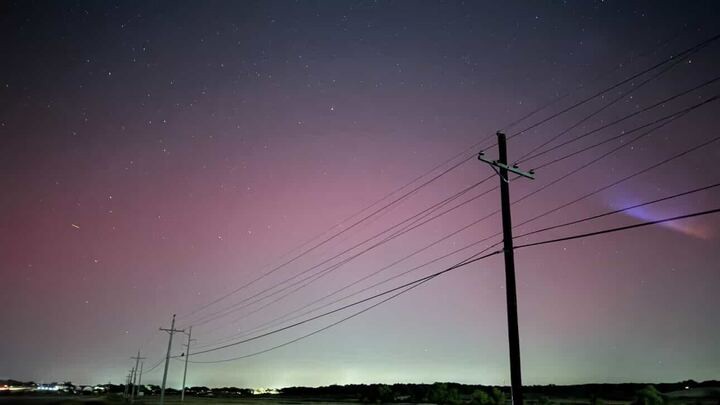news
Northern Lights Illuminate Central Texas Skies
Statesman readers shared striking images of the northern lights visible in Central Texas on Nov. 11 and 12, 2025.
Published November 13, 2025 at 2:30pm by Alexis Simmerman

The aurora borealis, also known as the northern lights, lit up skies above Austin on Nov. 11, 2025.
We asked, and our readers delivered!
A geomagnetic storm gifted Central Texas with striking views of the northern lights on Tuesday and Wednesday nights. Texas was one of at least 21 states with the potential to see the phenomenon.
Without further ado, here are some of photos you submitted.
Tuesday, Nov. 11
Lights from the aurora borealis reflect on Lake Buchanan near Black Rock Park on Nov. 11, 2025.
Northern lights are seen from Leander, Texas on Nov. 11, 2025.
The aurora borealis is seen from San Marcos, Texas on Nov. 11, 2025.
Wednesday, Nov. 12
Northern lights paint the sky in Florence, Texas on Nov. 12, 2025.
Northern lights paint the sky in Florence, Texas on Nov. 12, 2025.
Northern lights were spotted in a residential area in Lakeway, Texas on Nov. 12, 2025.
What causes the northern lights?
The aurora borealis appears in the sky when charged particles from the sun interact with Earth's magnetic field and atmosphere. The sun emitted a series of flare-ups, called coronal mass ejections (CMEs), between Oct. 11 and Oct. 13, per the Space Weather Prediction Center. Upon reaching Earth, the particles are channeled toward the polar regions by the planet's magnetic field — the field lines meet at the magnetic poles, which is why the northern lights are most visible in the northernmost region of the Northern Hemisphere.
When the particles from the sun hit Earth's upper atmosphere, they collide with gas atoms and molecules like oxygen and nitrogen. The collisions temporarily excite the atoms and raise their energy levels. As auroras form, Earth’s magnetic field redirects the particles toward the poles through a process that produces a stunning display of rays, spirals and flickers that have fascinated humans for millennia. Whether hues of green, red, blue and even pink dance about in the sky depends on the altitude where the collisions occur, as well as the composition and density of the atmosphere at the time.
Combinations of gas and altitude result in the following colors:
- Green: oxygen around 100 to 300 kilometers above Earth
- Red: oxygen above 300 kilometers
- Purple/Pink: nitrogen molecules
- Blue: nitrogen at lower altitudes
This phenomenon also occurs on the Southern Hemisphere; the southern lights are also called the aurora australis.
How do geomagnetic storms impact Earth?
While we won’t notice weaker solar activity, a geomagnetic storm may cause temporary disruptions to technology and electronic communications, but no major impacts are expected — except for the dazzling display of the northern lights.
Fortunately, Earth is shielded by its magnetic field, an invisible barrier that protects us from solar winds. When strong solar particles interact with gases in the atmosphere near the magnetic poles, they produce the vibrant colors of the auroras.

